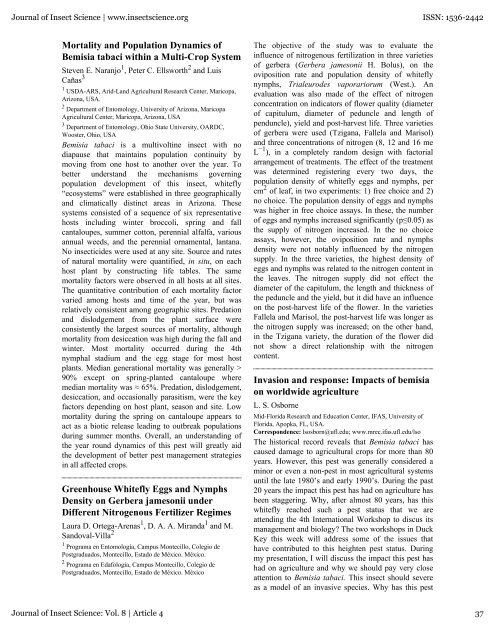Fourth International Bemisia Workshop International Whitefly ...
Fourth International Bemisia Workshop International Whitefly ...
Fourth International Bemisia Workshop International Whitefly ...
Create successful ePaper yourself
Turn your PDF publications into a flip-book with our unique Google optimized e-Paper software.
Journal of Insect Science | www.insectscience.org ISSN: 1536-2442<br />
Mortality and Population Dynamics of<br />
<strong>Bemisia</strong> tabaci within a Multi-Crop System<br />
Steven E. Naranjo 1 , Peter C. Ellsworth 2 and Luis<br />
Cañas 3<br />
1 USDA-ARS, Arid-Land Agricultural Research Center, Maricopa,<br />
Arizona, USA.<br />
2 Department of Entomology, University of Arizona, Maricopa<br />
Agricultural Center, Maricopa, Arizona, USA<br />
3 Department of Entomology, Ohio State University, OARDC,<br />
Wooster, Ohio, USA<br />
<strong>Bemisia</strong> tabaci is a multivoltine insect with no<br />
diapause that maintains population continuity by<br />
moving from one host to another over the year. To<br />
better understand the mechanisms governing<br />
population development of this insect, whitefly<br />
“ecosystems” were established in three geographically<br />
and climatically distinct areas in Arizona. These<br />
systems consisted of a sequence of six representative<br />
hosts including winter broccoli, spring and fall<br />
cantaloupes, summer cotton, perennial alfalfa, various<br />
annual weeds, and the perennial ornamental, lantana.<br />
No insecticides were used at any site. Source and rates<br />
of natural mortality were quantified, in situ, on each<br />
host plant by constructing life tables. The same<br />
mortality factors were observed in all hosts at all sites.<br />
The quantitative contribution of each mortality factor<br />
varied among hosts and time of the year, but was<br />
relatively consistent among geographic sites. Predation<br />
and dislodgement from the plant surface were<br />
consistently the largest sources of mortality, although<br />
mortality from desiccation was high during the fall and<br />
winter. Most mortality occurred during the 4th<br />
nymphal stadium and the egg stage for most host<br />
plants. Median generational mortality was generally ><br />
90% except on spring-planted cantaloupe where<br />
median mortality was ≈ 65%. Predation, dislodgement,<br />
desiccation, and occasionally parasitism, were the key<br />
factors depending on host plant, season and site. Low<br />
mortality during the spring on cantaloupe appears to<br />
act as a biotic release leading to outbreak populations<br />
during summer months. Overall, an understanding of<br />
the year round dynamics of this pest will greatly aid<br />
the development of better pest management strategies<br />
in all affected crops.<br />
Greenhouse <strong>Whitefly</strong> Eggs and Nymphs<br />
Density on Gerbera jamesonii under<br />
Different Nitrogenous Fertilizer Regimes<br />
Laura D. Ortega-Arenas 1 , D. A. A. Miranda 1 and M.<br />
Sandoval-Villa 2<br />
1 Programa en Entomología, Campus Montecillo, Colegio de<br />
Postgraduados, Montecillo, Estado de México. México.<br />
2 Programa en Edafología, Campus Montecillo, Colegio de<br />
Postgraduados, Montecillo, Estado de México. México<br />
The objective of the study was to evaluate the<br />
influence of nitrogenous fertilization in three varieties<br />
of gerbera (Gerbera jamesonii H. Bolus), on the<br />
oviposition rate and population density of whitefly<br />
nymphs, Trialeurodes vaporariorum (West.). An<br />
evaluation was also made of the effect of nitrogen<br />
concentration on indicators of flower quality (diameter<br />
of capitulum, diameter of peduncle and length of<br />
penduncle), yield and post-harvest life. Three varieties<br />
of gerbera were used (Tzigana, Fallela and Marisol)<br />
and three concentrations of nitrogen (8, 12 and 16 me<br />
L −1 ), in a completely random design with factorial<br />
arrangement of treatments. The effect of the treatment<br />
was determined registering every two days, the<br />
population density of whitefly eggs and nymphs, per<br />
cm 2 of leaf, in two experiments: 1) free choice and 2)<br />
no choice. The population density of eggs and nymphs<br />
was higher in free choice assays. In these, the number<br />
of eggs and nymphs increased significantly (p≤0.05) as<br />
the supply of nitrogen increased. In the no choice<br />
assays, however, the oviposition rate and nymphs<br />
density were not notably influenced by the nitrogen<br />
supply. In the three varieties, the highest density of<br />
eggs and nymphs was related to the nitrogen content in<br />
the leaves. The nitrogen supply did not effect the<br />
diameter of the capitulum, the length and thickness of<br />
the peduncle and the yield, but it did have an influence<br />
on the post-harvest life of the flower. In the varieties<br />
Fallela and Marisol, the post-harvest life was longer as<br />
the nitrogen supply was increased; on the other hand,<br />
in the Tzigana variety, the duration of the flower did<br />
not show a direct relationship with the nitrogen<br />
content.<br />
Invasion and response: Impacts of bemisia<br />
on worldwide agriculture<br />
L. S. Osborne<br />
Mid-Florida Research and Education Center, IFAS, University of<br />
Florida, Apopka, FL, USA.<br />
Correspondence: lsosborn@ufl.edu; www.mrec.ifas.ufl.edu/lso<br />
The historical record reveals that <strong>Bemisia</strong> tabaci has<br />
caused damage to agricultural crops for more than 80<br />
years. However, this pest was generally considered a<br />
minor or even a non-pest in most agricultural systems<br />
until the late 1980’s and early 1990’s. During the past<br />
20 years the impact this pest has had on agriculture has<br />
been staggering. Why, after almost 80 years, has this<br />
whitefly reached such a pest status that we are<br />
attending the 4th <strong>International</strong> <strong>Workshop</strong> to discus its<br />
management and biology? The two workshops in Duck<br />
Key this week will address some of the issues that<br />
have contributed to this heighten pest status. During<br />
my presentation, I will discuss the impact this pest has<br />
had on agriculture and why we should pay very close<br />
attention to <strong>Bemisia</strong> tabaci. This insect should severe<br />
as a model of an invasive species. Why has this pest<br />
Journal of Insect Science: Vol. 8 | Article 4 37
















